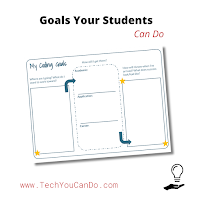Heads up ... this blog is somewhat a departure from my usual. I promise it 100% has to do with tech and education. Here's the back story:
I have 3 daughters - ages 18, 14, and 12. They all have phones. I have been reluctant to allow them social media, but my oldest does have Tik Tok, Snapchat, Instagram, and Facebook. My middle daughter has Tik Tok and Pinterest. And my youngest doesn't have any. This year I went back into the classroom, teaching technology to grades 6-7-8, but in a new district.
I've been doing a lot of learning about how devices are impacting our kids. Books, articles, podcasts, etc. This past week, the topic of phones in schools came up in one of my PLN's. I believe the person who began the conversation was asking about other district policies on phones in schools. I love reading others opinions and learning how other districts - across the country - are handling devices in schools.
I chimed in with links to some of the resources I've come across regarding this topic. I received several positive responses and thank you's for the information, so I thought I'd share them with you, too.

I will be the first to admit I was in the camp of using devices (iPods/phones) back before we were 1-to-1. Having multiple devices in a classroom opened my eyes to the power technology can have in education. The accessibility and creation that is possible was awesome. But then my district went 1-to-1 with chromebooks. Every student was given a device. And around that time, phones became more and more common, and with younger and younger students, and the problems really began. Phones are not built to be tools of instruction. Have you ever tried to write an essay on your phone? Possible, yes, but not great.
The book, Screen Kids, by Gary Chapman & Arlene Pellicane, is such an incredible read. It is not long but it is packed with research and solid thinking. It truly helped me put some specifics to the thoughts and feelings I'd been having regarding devices. If you are a parent, read this. If you are an educator, read this. If you are a grandparent, check out Grandparenting Screen Kids: How to Help, What to Say, and Where to Begin, by the same authors. This book helped me have better - and MORE - conversations with my own daughters.
Here are additional resources I've been learning from on this topic that might be of interest to you:
- Does banning phones in school improve students’ mental health? from Angela Watson - this is a link to her blog. In it, it contains a link to this also as a podcast. Angela interviews psychologist Dr. Jean Twenge and get hers profession opinion.
- Cell phone policy leads to school of distinction from the Wektumpka Herald. This story shares how a local high school has changed their policy regarding cell phones and the impact it has had ... and the award they've received as a result.
- How Teens and Parents Approach Screen Time from the Pew Research Center. This article digs into the research behind the difference in how parents and teenagers differ in their handlings of screens. Fact shared that caught my eye, "72% of U.S. teens say they often or sometimes feel peaceful when they don’t have their smartphone; 44% say it makes them feel anxious." Wow!
- How to Talk to Your School District about Removing Smartphones from Protect Young Eyes, a group who focuses on helping "Families, Schools, And Churches Create Safer Digital Environments". This article focuses on the school aspect.
- Constant Companion: A Week in the Life of a Young Person's Smartphone Use from Common Sense Media. Fully disclosure - I've not gotten all the way through this massive resource yet. There is a 64 page report along with several other resources to check out. Common Sense Media is a fantastic resource for so many tech related needs.
Finally, I always try to remind others when I have conversations, use the tool that is appropriate for the task. If it's task that is best on paper, use paper. If a computer is what is needed, use it. If it's a face-to-face conversation, do it in person. And if it's phone, use a phone.
Do you have a resource that is related to this topic? Please share! I'd love to read it.
*** Every Monday, I share a newsletter with a collection of Tech You Can Do resources. It is delivered right to your inbox. Interested? Sign up here! ***



.png)
